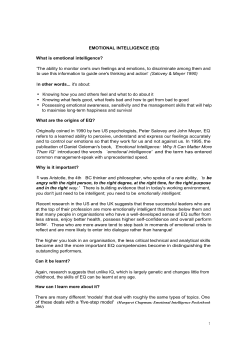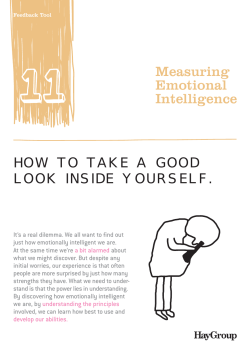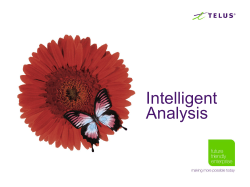
11/29/2013 Emotional Intelligence in Workshop Agenda
11/29/2013 Workshop Agenda • Introduction & Overview • What Is Emotional Intelligence (EI)? – Ability, Mixed Model and Trait Theories Emotional Intelligence in Medicine • Lunch Break (12.00-13.00pm – 45m) • Developing EI Intrapersonal Skills • EI in Medicine & Medical Leadership • Coffee break (15m) • Developing EI Interpersonal Skills • Summary & Close Safiatu Lopes Workshop Objectives 1. To define emotional intelligence and explore it’s importance in the medical context What is Emotional Intelligence? 2. To increase participants’ awareness of how emotions influence decision-making and impact upon interactions/relationships 3. To develop participants’ skills in effectively managing colleague or patient interactions 4. To develop participants’ confidence in managing challenging interactions Emotional Intelligence – Origins? “IQ contributes about 20 percent to the factors that determine life success, which leaves 80 percent to other sources” (Goleman, 1995) Do you agree?? • Rooted in social intelligence (Thorndike, 1920) – ‘the ability to understand men and women, boys and girls: to act wisely in human relations’ • Heuristic for integrating a range of related, but diverse, literature on individual differences in processing emotional information (Salovey & Mayer, 1990, 1993, 1995) • Popularised by Daniel Goleman (1995, 1998) • Huge industry offering EI products & training services with a range of definitions & models 1 11/29/2013 What is Emotional Intelligence? • Psychological construct: a characteristic in which individuals differ • “The subset of social intelligence that involves the ability to monitor one’s own and others’ feelings and emotions, to discriminate among them and to use this information to guide one’s thinking and actions” (Salovey and Mayer, 1990) • “Array of non-cognitive capabilities, competencies, & skills that influence one’s ability to succeed” (Bar-On, 1997) • “A constellation of emotional self-perceptions located at the lower levels of personality" (Petrides et al 2007) Emotional Intelligence Literature surrounding EI makes a distinction between: i. Ability EI (linked to intelligence) ii. Mixed models of EI (define EI as a set of personality characteristics mixed in with EI abilities). iii. Trait EI (linked to personality) Emotional Intelligence • Definitions include: – Understanding & managing one’s own emotions: intrapersonal or self-awareness – Recognising the emotions of others and managing them effectively in our relationships: interpersonal awareness • Provides a useful framework for development activities about managing emotions outside of a care model • But ... heated debates remain about nature of EI Emotional Intelligence Models Four dominant models (Cherniss, 2010): Ability Model Mayer, Salovey & Caruso, 1997; 2004 Mixed Models Bar-On, 1997 Trait Models Petrides, 2001; Boyatzis & Goleman, 2002 EI Ability (Mayer & Salovey, 1990) Emotional Intelligence as an Ability First to define emotional intelligence Emotions are valuable sources of information that help a person to interpret and navigate the social environment Their model assumes the following: • EI is the interconnection between emotion and intelligence • Each person varies in their ability to process emotional information • There are four types of ability 2 11/29/2013 Types of EI Abilities MSCEIT v2 Measure • Perceiving & Expressing Emotions: ability to identify emotions in faces, pictures, voices, including ability to detect one’s own emotions. • Generating & Using Emotions: ability to harness emotions to facilitate various cognitive activities, like problem solving or decision-making. • • Understanding Emotions: ability to comprehend causes of emotions, their progressions & relationships among emotions. Managing Emotions: ability to regulate emotions in both ourselves & in others so as to help enhance decision-making. Mayer & Salovey (1990) • The MSCEIT v2 is a 141-item test measuring how well people perform and solve emotional problems on eight tasks • Score for each EI Ability, plus overall score • Two scoring procedures: a) General consensus criterion based on answers of more than 2,000 respondents b) Expert consensus criterion based on members of International Society of Research in Emotion (N=21) – Correlation of .91 between the 2 methods Mayer et al., 2002 MSCIET v2 Sample item 2 MSCIET v2 Sample item 1 Perceiving Emotions Indicate how much of each emotion is present in this picture. Emotion Not Much Very Happiness 1 2 3 4 5 Fear Sadness Surprise 1 1 1 2 2 2 3 3 3 4 4 4 5 5 5 Using Emotions What mood(s) might be helpful to feel when meeting in-laws for the very first time? Tension Surprise Joy Not Useful 1 1 1 Useful 2 2 2 3 3 3 4 4 4 Emotion Not present Present Anger 1 2 3 4 5 Happiness 1 2 3 4 5 Sadness 1 2 3 4 5 Surprise 1 2 3 4 5 Evidence for MSCEIT v2 MSCIET v2 Sample item 3 Mood Perceiving Emotions In this part you will be look at a picture or design. Look at it and then indicate the feelings expressed in the picture 5 5 5 • Good internal reliability (ranging from .80 to .91, and .91 for the entire test) • Scores have been found to correlate with intelligence measures, while also showing unique variance. • As expected, scores increase with age • Predictive of: – Academic success – Deviant behaviour – Subjective well-being – Good social relationships 3 11/29/2013 Ability EI - Key Questions • Does it matter that there are no absolute right or wrong answers? • What do EI ability tests actually measure ... ability, knowledge or conformity? • Is measuring the ‘best someone can do’ in terms of EI useful in the workplace and if so when? EI Mixed Model (Bar-On, 1997) Define emotional intelligence as “array of non-cognitive capabilities, competencies, and skills that influence one’s ability to succeed” EQ-i includes five composite factors: 1) Intrapersonal EQ 2) Interpersonal EQ 3) Adaptability 4) Stress management 5) General mood – Reality Testing – Flexibility – Problem Solving 4) Stress Management – Stress Tolerance – Impulse Control 1) Intrapersonal EQ – Self Regard – Self Actualization – Emotional SelfAwareness – Emotional Expression – Assertiveness – Independence 2) Interpersonal EQ – Empathy – Social Responsibility – Interpersonal Relationships • EQ- i 2.0 is a 133item test • Self-report measure 5-point Likert scale (very seldom true of me – very often true of me) • Total EQ-i score = sum of 118 items 5) General Mood – Happiness Bar-On EQ-i EQ-i 2.0 Bar-On EQ-i 3) Adaptability Emotional Intelligence as a mixture of personality traits and abilities – Optimism • Scores for each of the 5 composite scales, 15 subscales, as well as a ‘general wellbeing indicator’ 4 11/29/2013 Evidence for the EQ-i 2.0 Mixed EI - Key Questions • Good internal reliability (ranging from = 0.69 to 0.86 across the 15 sub-scales) • Predictive of: – Academic success – Job performance – Leadership – Sales – Presence of some clinical disorders • Does the model capture anything that isn’t already captured by existing personality measures? • How reliable can a self-report measure be in assessing ability? Trait EI (Petrides, 2001) • Defines emotion intelligence as: “a constellation of emotional self-perceptions located at the lower levels of personality hierarchies” (Petrides et Emotional Intelligence as a Trait al, 2007) • The model assumes the following: – EI encompasses behavioural dispositions & selfperceived emotional abilities – There is no archetypal ‘emotionally intelligent type’ – Integrates EI into mainstream theories of psychology Facets High Scorers view themselves as .... Trait empathy capable of taking someone else’s perspective Emotion expression capable of communicating their feelings to others Relationships capable of maintaining fulfilling personal relationships Emotional perception (self & others) clear about their own and other people’s feelings Emotion regulation capable of controlling their emotions Impulsiveness (low) reflective and less likely to give in to their urges Stress management capable of withstanding pressure & regulating stress Assertiveness forthright, frank, and willing to stand up for their rights Emotion management (others) capable of influencing other people’s feelings Social awareness accomplished networkers with superior social skills Self-esteem successful and self-confident Adaptability Trait happiness cheerful and satisfied with their lives Motivation Trait optimism confident and likely to ‘‘look on the bright side’’ of life Adaptability flexible and willing to adapt to new conditions Self-motivation driven and unlikely to give up in the face of adversity Trait EI Model Traits grouped into four facets: Emotionality • Empathy • Emotion perception • Emotion expression • Relationships Self control • Emotion regulation • Impulsiveness • Stress management Sociability • Assertiveness • Emotion management • Social awareness Well-being • Self-esteem • Happiness • Optimism 5 11/29/2013 TEIQue (Petrides, 2001) TEIQue Sample Items • The TEIQue is a 153-item test • Self-report measure 7-point Likert scale (Disagree Completely - Agree Completely) • 15 subscales, 4 factors • Evaluates typical performance (no ‘right’/‘wrong’ answers) Evidence for the TEIQue • Good internal reliability (ranging from α = 0.70 to 0.88 across the 15 subscales and .90 for the global score) • Predictive of: – Job performance – Organisational commitment – Mental health Trait EI - Key Questions • Is understanding people’s behavioural dispositions & perceived abilities useful in the workplace and if so for what? • Are all trait-based measures suitable for use in the workplace? • Does it matter that measures are open to faking? Emotions & Behaviours at Work • Personality-based, specific for examining EI in an occupational context • Premise that EI can be improved Exercise: Example Measure of EI • Helps individuals & teams understand why people behave the way they do – Aims to maximise their performance – Questions only work-related • Emphasis is developing awareness of the strengths and weaknesses associated with every score on the emotional behavioural clusters 6 11/29/2013 The EBW measures the following behavioural clusters or scales... EBW Self Assessment Sheet User Name Comparison group Date Decisiveness Decisiveness Is comfortable taking a lead from others and will delay making until all of the information is available and he/she has had sufficient time to evaluate time to evaluate the situation fully. Likes making decisions and taking on responsibility, actively seeking to put forward his/her views and taking a leading role Motivation/Drive Motivation/Drive Is likely to deal with his tasks in a methodical manner without engaging emotionally in his/her role, reacting to the needs of the situation rather that driving a particular approach or agenda forward Is likely to become passionate about tasks and roles he/she engages in, putting a great deal of energy into them and actively seeking and expecting positive outcomes. Influence Influence Does not feel a need to have an impact on others and is comfortable in roles that do not have a high profile or that lack the opportunity to influence others. Is a competitive person who likes to win and to have an impact on others; enjoying high profile roles Adaptability Adaptability Comfortable with highly structures and regulated working environments; Likes following routine procedures and may not like change. May have a procedural thinking style Comfortable with uncertainty and change; Is likely to work in a relatively unstructured way and will be open to new ideas and approaches. May well be creative in his style of thinking and working Empathy Empathy Dealing unemotionally and rationally with issues and being task focused. Is comfortable working without the support of others and may prefer to remain distant from those he/she is working with. With a strong person focus to his/her working style, is likely to be a highly supportive and accessible colleague, who may put the needs of others above the requirements of the task. Conscientiousness Conscientiousness Is concerned with achieving goals in the most expedient and effective manner available and will not feel overly constrained by the rules and conventions that apply to the organisation. Reliable and consistent, is very concerned to meet his/her commitments and to do so in a way that is acceptable to those around him/her. Stress Resilience (Emotional Control) Stress Resilience (Emotional Control) May find the day-to-day pressures of life more difficult to manage than many and this may make him/her more aware of, and sensitive to, the way stress affects others. Is comfortable dealing with the day-to-day stresses of life and is better able than most to remain calm and in control of his/her emotions. EBW Self-assessment How do Doctors perform on the EBW? Instructions: • Same as managers & other professional groups, but lower than senior managers for: Decisiveness, Motivation, Influence 1. Read through the polar descriptions and place a cross somewhere in the box below, to indicate where you think you lie between the two. • Same as managers and senior managers, but higher than other professional groups for: Conscientiousness • No difference between any groups for: Empathy, Stress Resilience, 2. Now look back at your markings and consider how your behaviour changes in relation to any of these dimensions when you are under pressure? – Make additional marks on the self assessment sheet to indicate how. Developing EI Intrapersonal Skills Emotional Control • Score lower than all managers and other professional groups for: Adaptability But ... early analysis – sample size for doctors only 82 so far “I don’t want to be at the mercy of my emotions. I want to use them, to enjoy them, and to dominate them.” - Oscar Wilde 7 11/29/2013 Developing EI: Intrapersonal Skills • First step to increasing EI is developing selfawareness, in other words, know thyself • Reflection is key to this, but is dependent on: – – – – – Being honest and open with yourself and others Being open to considering alternative viewpoints Listening and seeing things from other’s viewpoint Being motivated to want to engage in personal development Willing to ask for feedback • Facilitated group or 1:1 sessions can be beneficial Self-awareness Techniques: Self-awareness can be developed by: • Identifying typical situations where EI skills are important in your role (e.g. working with challenging patients, resolving conflict or making tough decisions). How do you tend to feel and behave in these situations? • Taking time to review how you approached a challenging situation, ask yourself how you felt during this situation and the impact this had on your behaviour. Is there anything which you could do differently? • Asking colleagues for feedback on your approach and comparing this to your own evaluation of the situation. Johari Window on Self-awareness • Asking others reduces the blind area, telling reduces the façade area • Can provide basis for mentoring/coaching • But be careful - there are reasons for these boundaries... (Luft & Ingham 1954) Exercise: Managing emotions: yours and others (20m) • In pairs, think of a time when you handled interpersonal conflict inappropriately in your professional life. Spend 5 minutes writing down responses to the following questions & then discuss: – – – – What did you do that was not helpful? What emotions did you feel? What emotions do you think the other person felt? How might you have better managed the situation more successfully? – What skills might you have used to do this? Developing EI: Self-Management 1) Be Aware of Your Feelings. Paying attention to how you feel—in the moment—is the first step to more effective selfmanagement of your behaviour. 2) Practice Self-Control. Stop and think before acting; pause and consider the best course of action in the present situation. 3) Integrity. Act in accordance to your values. 4) Take initiative. Take necessary actions to clear away negative emotions, resolve conflicts, solve problems and accept responsibility for your own development. 5) Manage Stress. Learn to spot stress triggers and recognise them for what they are. Practice methods of bringing yourself back to feeling calm and relaxed. Importance of EI in Medicine 8 11/29/2013 Developing EI in the Workplace • Well-designed & tailored EI interventions can be beneficial to some aspects of job performance – developing confidence and competence to deal with emotionally charged situations (Koczwara & Bullock, 2009) • EI has the strongest relationship with job performance in roles with high frequency, high severity & high duration of exposure to emotionally charged situations (Schmit, 2006) Exercise: Understanding your own emotions (15m) • What emotional demands does your work as a doctor make on you? – On your own, create a list to share with the group (5 minutes) – How do you feel when you experience them? – How do you deal with these? – What support is available to you? EI Research in Medicine Medical Education, 2010; 44;749-764 “Our review revealed a plethora of potential applications of EI to medical education ... The pervasive link between EI and doctor competence carries significant implications for medical training ” • Arora et al’s review (2010) reports: – direct links between EI and interpersonal & communication skills – indirect links between EI and practice-based learning & improvement – higher EI is associated with more compassionate & empathetic patient care – EI contributes to improved teamwork & doctorpatient communication Implications for Medicine? • Educate doctors in EI-related skills to enable them to better achieve their required competence? • Use EI concepts to provide an evidence-based classification of the type of non-technical skills that medical training has traditionally found hard to address? EI & Medical Leadership • Use EI to provide a vocabulary for the provision of systematic feedback to trainees to enable them to get the most out of learning opportunities? 9 11/29/2013 EI & Leadership • Qualitative research suggests that IQ measures are unable to account for large portions of the variance related to performance and career success in top managerial positions (Fernandez-Araoz, 2001). • Goleman (1998) - qualities traditionally associated with leadership—such as intelligence, toughness, determination, and vision—are required for success, are insufficient. Truly effective leaders are also distinguished by a high degree of emotional intelligence, which includes self-awareness, selfregulation, motivation, empathy, and social skills. EI & Leadership Research • Research has found links between effective leadership and the following: – – – – – – – – – – Exercise: Effective leadership (15m) • Think about the best leader or manager you have ever worked for: – Write down a list of their qualities and characteristics to share with the group (5 minutes) – How many of these could you classify as EI traits/abilities? – Which do you consider the most important and why? Links to NHS Medical Leadership Competency and Leadership Qualities Framework Participative management Putting people at ease Self-awareness Work-life balance Straightfowardness and composure Building and mending relationships Doing whatever it takes Decisiveness Confronting problem employees Change management Developing EI: Interpersonal Skills Developing EI Interpersonal Skills • Having good communication skills makes it easier to send across and receive messages to/from colleagues and patients that are clear, to-the-point and respectful of both your own boundaries and those of others. • Three V’s of communication: – Verbal (7%) – Vocal (38%) – Visual (55%) 10 11/29/2013 Non-Verbal Communication • Encompasses: facial expression, body movements & posture, gestures, eye contact, touch, space, tone of voice, etc. • Important for: – – – – Reinforcing/modifying a verbal message Conveying information about one’s emotional state Providing feedback to another person Regulating flow of communication • Mirroring another person’s action(s) while interacting with them has been shown to increase rapport and positive feelings Exercise: Active Listening (15m) 1. In pairs, select an issue on which you have differing opinions…either a work related issue or a social issue. 2. Begin your conversation with one person sharing their perspective on the issue. The other person should listen intently, and apply active listening techniques to show that they understand the speaker’s message. Active Listening Techniques Adults are usually distracted by other things while they listen, and therefore, hear at about 25% efficiency! 1. Let the speaker know that you are listening with well-timed and short replies, e.g. I see, or yes, or tell me more, or even by nodding. 2. Paraphrase speaker’s messages to make sure you are understanding, and also to show an effort to understand. 3. Identify the emotion the speaker is feeling (e.g. ‘it sounds like you are upset…’) 4. Ask open-ended questions, rather than ‘Why?’ 5. Use ‘I’ statements rather than ‘You’ statements (sound less accusatory) 6. Effective pauses. Sometimes not saying anything at all is more effective! This can allow the speaker to share more. Exercise Debrief: Active Listening • Did you feel that you and your partner understood each other better or that you made some headway in solving the problem? • What was it like to focus so intently on understanding the meaning of someone else’s communication, rather than on what you were going to say? 3. The spotlight stays on the first speaker until they are satisfied that their partner clearly understands their perspective. 4. Switch roles! • What did you personally have to let go of to listen effectively and “check out your thinking maps?” Developing EI: Relationship Management Exercise: Challenging service interactions (15m) 1) Think Win/Win. Seek mutually beneficial relationships and agreements. Try to avoid conflict where possible. 2) Seek First to Understand, Then to Be Understood. Pay attention to non-verbal communication and actively listen – this will help you appreciate their perspective and respond much more effectively. 3) Boundaries. Be assertive with others about your personal and professional boundaries. Take the time to understand and respect other people’s boundaries. 4) Synergise. Find ways to build powerful alliances with people that allow you all to accomplish feats that would be virtually impossible for a single person. Know what motivates your allies and what they can contribute. • In groups of 3-4, each recall one recent conflict that involved either a patient or their family. – What do you believe triggered the conflict? Do any ‘toxic words’ come to mind? – How did it make you feel? – What do you think the patient or their family was feeling at the time? – How did you handle the situation? – In what ways could you have handled the situation better? 11 11/29/2013 Summary • Emotions are an everyday part of our working lives, particularly in high-stakes, interpersonal interactions • Emotional intelligence can be conceptualised as an ability or personality trait Summary & Conclusions • Either perspective assumes that EI skills can be developed to enhance effectiveness in the workplace • Tools and exercises exist to support EI development • Self-awareness and inter-personal awareness are key to both approaches and development of them forms the basis of most EI-based interventions • Application in medical context increasing but more evidence required regarding use in professional development Thank you! s.lopes@workpsychologygroup.com 12
© Copyright 2025





















